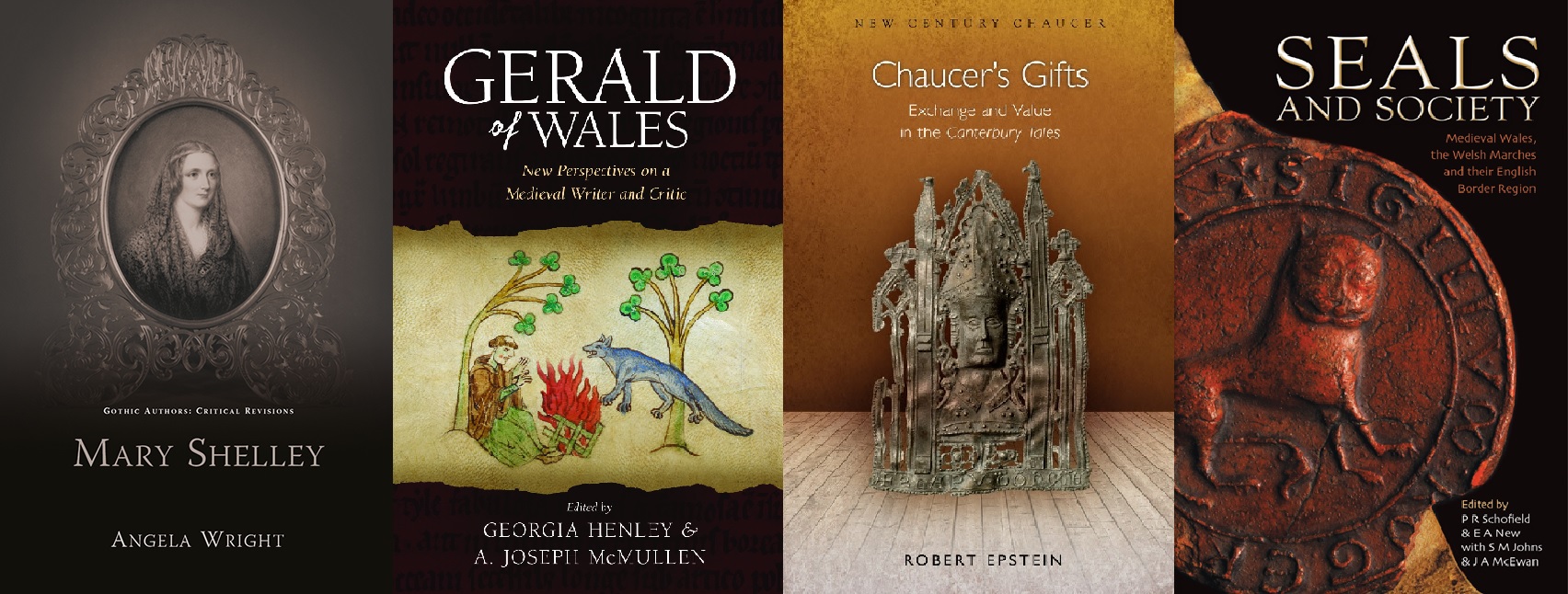We’re hitting the ground running in 2018 with several exciting releases over the next few weeks, including an important collection of essays on Gerald of Wales, a fresh examination of Mary Shelley’s work within the Gothic tradition, and a major study on gift theory in Chaucer’s Canterbury Tales. If you would like to pre-order any of these books, please follow the links below.
Mary Shelley, by Angela Wright – January 2018 (hardback, paperback, ebook)
Mary Shelley reappraises the significance of Frankenstein alongside other works by Shelley which could be considered to revise the significance and fluctuating meanings of ‘Gothic’ during the Romantic period. It offers scholarly, fresh readings of the 1818 and 1831 editions of Frankenstein, as well as chapters upon the fiction that Shelley composed between both editions, and during the same decade as its second edition.
In its broader examination of Mary Shelley’s work, this study is the first of its kind within the field of Gothic studies. Alongside sustained explorations of Frankenstein, Matilda, Valperga and The Last Man, the volume Mary Shelley reappraises some of the shorter essays and tales that the author composed for contemporary magazines. Angela Wright argues that the time is now right for a re-examination of the extent to which Shelley participated in and redirected the Gothic tradition.
Chaucer’s Gifts: Exchange and Value in the Canterbury Tales, by Robert Epstein – February 2018 (hardback, paperback, ebook)
Geoffrey Chaucer’s Canterbury Tales, the most celebrated literary work of medieval England, portrays the culture of the late Middle Ages as a deeply commercial environment, replete with commodities and dominated by market relationships. However, the market is not the only mode of exchange in Chaucer’s world or in his poem. Chaucer’s Gifts reveals the gift economy at work in the tales. Applying important recent advances in anthropological gift theory, it illuminates and explains this network of exchanges and obligations. Chaucer’s Gifts argues that the world of the Canterbury Tales harbours deep commitments to reciprocity and obligation which are at odds with a purely commercial culture, and demonstrates how the market and commercial relations are not natural, eternal, or inevitable – an essential lesson if we are to understand Chaucer’s world or our own.
Gerald of Wales: New Perspectives on a Medieval Writer and Critic, edited by A. Joseph McMullen and Georgia Henley – February 2018 (hardback, paperback, ebook)
Gerald of Wales (c.1146–c.1223), widely recognised for his innovative ethnographic studies of Ireland and Wales, was the author of works that touch upon many aspects of twelfth-century life. Despite their valuable insights, these works numbering twenty-three have been vastly understudied, and the collection of essays in the present volume reassesses Gerald’s importance as a medieval Latin writer by focusing on the lesser-known works, and by providing a fuller context for his better-known writings. This broader view of his corpus brings to light new evidence for the rhetorical strategies that he employed, his political positioning, and his use of source material, in attesting to the breadth and depth of his work.
Seals and Society: Medieval Wales, the Welsh Marches and their English Border Region, by Phillipp R. Schofield, John McEwan, Elizabeth New, Sue Johns – January 2018 (hardback, paperback, ebook)
New in paperback. Seals and Society arises from a major project investigating seals and their use in medieval Wales, the Welsh March and neighbouring counties in England. The first major study of seals in the context of one part of medieval Western European society, the volume also offers a new perspective on the history of medieval Wales and its periphery by addressing a variety of themes in terms of the insight that seals can offer the historian. Though the present study suggests important regional distinctions in the take-up of seals in medieval Wales, it is also clear that seal usage increased from the later twelfth century and spread widely in Welsh society, especially in those parts of Wales neighbouring England or where there had been an early English incursion. Through a series of chapters, the authors examine the ways in which seals can shed light on the legal, administrative, social and economic history of the period in Wales and its border region. Seals provide unique insights into the choices individuals, men and women, made in representing themselves to the wider world, and this issue is examined closely. Supported by almost 100 images gathered by the project team, the volume is of great interest to those working on seals, their motifs, their use and developments in their usage over the high and later Middle Ages.


